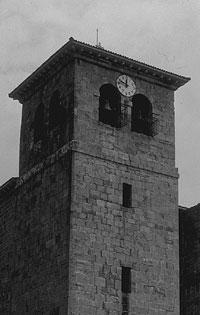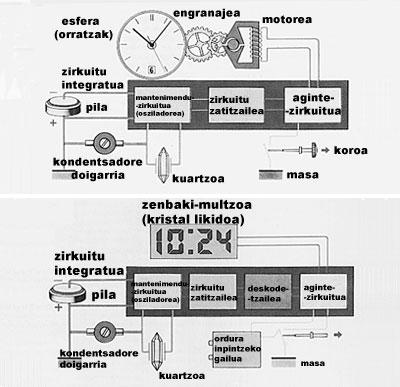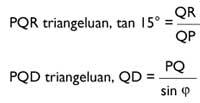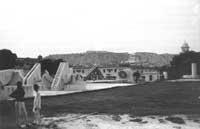Watches
1996/06/01 Irureta Azkune, Onintza Iturria: Elhuyar aldizkaria
Day and night, seasons, sun or stars have long been used to measure time. From these natural sources, man began to take steps in time measurement methods.
Among those who have come to us, one of the oldest watches is the hourglass, the solar clock and the clepsid. Sundial a. C. XX. It has been known since the 20th century. This type of watch began to be used to know the time of residence in China and India. These solar clocks are not for us strangers, as they can still be seen on the walls of various churches of our villages. The solar rays are directed to a rod attached to the wall and the rod, on the other hand, makes shade in the lines of the hours drawn. Thanks to this shade you can know what time it is. But the help of time was fundamental for that invention to serve, since the clock was useless without sunlight.
The hourglass is as well known as the sundial, and less known the hourglass, the clepsid. At the beginning of the Middle Ages we found these inventions that the lords and the churches used to fix in a certain schedule both working hours and religious celebrations.

The clepsid is just a graduated container full of water. For the water to come out regularly, a hole would open under the bowl. Along with the water a small piece of bronze was used to be released through the lower hole and the noise it made when falling into a second container allowed to warn the passage of time. VIII. In the eighteenth century Carlo Magno himself used the clepsid and knew that when he heard the noise of it, he had just spent an hour.
By adapting and renewing the aforementioned systems, our ancestors quantified and classified the displacements of the years.
Carlos V, in addition to being king of France, discovered his place in the history of the clock. The king ordered the placement of a clock in the tower of the palace of Paris. But the king did not want any watch, but a mechanical watch. Event XIV. This watch, made by Charles V in the mid-20th century, was considered the first watch in the mechanical system. These gadgets began to proudly show up in churches and public buildings. However, the first watches were very large and heavy and cannot be compared to the precision obtained today. These first mechanical iron watches hung from a cable with weights and the watch was influenced by weight. As I was releasing, the cable marked the passage of time.
For centuries mechanical watches were improving. One of the biggest advances was the laying of pendulum on the structure of mechanical watches. In 1657 Christian Huygens invented the clock with pendulum and since then they were able to measure time more accurately than until then.
We have to jump until 1840 to find the first electric clock. Over time these watches also gave more precision and in 1952 the first electric wrist watch could be seen.
Discovering the Hidden
No wonder what you're reading carries a watch on your wrist. Circular or square, classic or modern, with needle or digital. In one way or another, who doesn't use a watch? In a society in which we live in haste, we have every minute of the day well measured, but in haste, have you ever wondered why the needles move or why do the numbers change?
As we have seen, different types of watches have been made throughout history. Using simple and affordable elements like water, sand and sun, then with gear wheels, teeth, pendulums and weights. One of the most common for us is the watch we wear on the wrist, both analog and digital. Both have the same basic component: quartz. Starting from the quartz block, this small surface produces a complete electronic mechanical-electric process.
This part of the mineral we can find inside the watch is not cut in any way. Quartz is prepared taking into account the electric axis. But only with this piece of glass would we not start the clock. Quartz should vibrate for the watch to work and for this a battery is used. The circular stack of silver oxide consumes very little and can be supplied for at least one year. Quartz has mechanical vibrations and emits a wave. Thanks to its small size, the frequency of vibrations is very high, 32768 Hz.
The next important section of the clock is the so-called dividing circuit. In this circuit there are fifteen dividers that divide the frequency of quartz with two numbers each. 32768 dividing fifteen times by two numbers comes out 1, that is, a vibration per second.
This electronic circuit, through the control circuit, is connected to an electromagnet. Specifically, a coil is the one that makes binding. Every second passes through the coil an alternating current that takes a mile of a second. Therefore, now these vibrations will reach the electric motor that will move the gears.
But let's pause. All steps so far are taken in the hidden mechanisms of the watch. The last step we mentioned is going to make a connection between the exterior and the interior. The last gear is touching the needle and every time this gear moves the needle will move a little, a second. After sixty movements of this gear, a new gear will move, which attached to the second needle will also move; a minute has passed.

Wet numbers
Analog clocks, the needle clocks, are widely used today, but digital clocks have not been left behind. Digital watches have no needles but numbers. While needles are electronic-mechanical, digital needles are fully electronic. The difference between the two can be seen both from the outside and from the inside.
In addition to the sections mentioned when explaining the structure of the analog clock, the digital clock has other mechanisms. Within the integrated circuit, the digital ones have a fourth element: the decoder. The decoder has its place between the splitter circuit and the control circuit.
Since the structure we have mentioned is internal, we do not see it, if we do not explore the interiors and begin to look. The outer difference between the analog and digital clock is also evident. The first has needles and the second shows us a set of numbers. The numbers are in liquids. This liquid is between two glass plates. The invention was magnificent, as they look clearly and can also be kept in good condition for a long time.
The hook to be able to measure time with increasing precision has been over time. They started by hourglasses, sundials and clepsida, trying to control the days and months. The most advanced system we have now to measure time is the so-called atomic or molecular clock. The highest precision of frequency has been known in atomic or molecular phenomena, so they have been used to obtain maximum precision as time goes by.
They have been designed to measure watches of great precision or less exact, all of them, that line that advances without stops, time. In this effort we have surrounded our life of clocks; at home, at work, on the street, in the car..., even in the bedside table, we have set an alarm clock for the fingers of the advance to wake us from the sweet dream.

Gai honi buruzko eduki gehiago
Elhuyarrek garatutako teknologia





